Fernanda Dahlstrom reviews “Homesickness” by Janine Mikosza
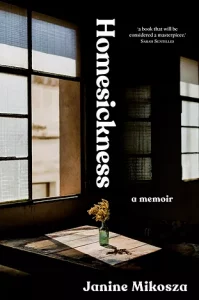 Homesickness
Homesickness
by Janine Mikosza
ISBN 9781761150234
Reviewed by FERNANDA DAHLSTROM
Homesickness is a memoir that strives, as Emily Dickenson urged, to tell all the truth, but tell it slant. Memoirs are reconstructions that seek to capture the voice and perspective of one or more of the writer’s younger selves. Their truth claims are subject to dispute, challenge, and counterclaim. But Melbourne artist and sociologist Janine Mikosza takes a more oblique approach to her subject and the result is a soaring view of the emotional trajectory of her life and of the philosophical questions that its telling raises. When Homesickness opens, she is having cake with a nervous and sometimes hostile woman who tells her to call her Jin as ‘It’s better than Janine.’ After she gets permission from the woman to write her story, it becomes clear that the two women are different iterations of the same person: the narrator is the memoirist, while Jin is the woman who lived her childhood trauma and is still struggling to process it. The book unfolds as a dialogue between author and protagonist, with the two often at cross-purposes, as Mikosza struggles to balance writing about the past with recovering from it.
Jin takes Janine on a tour of the many houses she lived in as a child, hinting at the trauma and violence that is intimately linked to their rooms. We are not given details of what occurred or who the perpetrator was. Jin doesn’t want to reveal everything and ‘add to the literature on family violence piling up like dead bodies in bookstores’ (p. 16). Rather, the spacial dimensions of Jin’s trauma are alluded to via a serious of floorplans. She does not answer the question ‘What happened in those rooms?’ (p. 109) but alludes to a terror of bathrooms, which she repeatedly omits from her sketches. In this way, Mikosza maintains privacy and avoids neatly playing into the trauma genre. The two characters’ disagreements highlight a lot of the questions memoir raises – who is more qualified to tell a person’s story, the elder or younger self? To what extent should a structure be imposed over the messiness of lived experience? How much do factual details matter to the emotional truth of an event? Why should a person entrust their story to a memoirist and what happens if they get it wrong?
Mikosza also presents an indictment on systemic failures to deal appropriately with trauma. When the conversation turns to sex offenders in the priesthood, Jin rails against ‘those fucking men and their supporters’ (p. 123), and weeps when describing how their victims were treated, though she says she was not one of them. When relating the birth of her son, she remembers the obstetrician’s insensitivity, his failure to ask permission before cutting her open, and refusal to respect her concerns about being retraumatised by a vaginal birth. At other points in her story, she resists the memoirist’s cross-examination, refusing to give up control of her own experiences:
Don’t you trust me enough to tell me some more?
Haven’t I given you enough already? she replies.
Not the important parts.
How do you know what the important parts are?
Will you trust me with your life? Please?
Depends what you’re planning to do with it, Jin says. (p. 98)
In Mikosza’s self-talk, we see her simultaneously presenting as a competent professional and as a young woman as incoherent as any client telling her story for the first time. The author strives for specific, quantifiable, and linear claims, impulses associated with the evidence-based disciplines of science and law, and which the survivor thwarts. At times, the dialogue also evokes aspects of the therapeutic relationship, reminiscent of what therapists call ‘reparenting’: consciously giving oneself the nurturance, empathy and protection that was not received in childhood. The duality captures the paradox of survivors of trauma: one can simultaneously be a high-functioning adult and a deprived and terrified child. And coming to terms with the past may be the key to reconciling these selves.
When the conversation reaches Jin’s adult life, the narrative relaxes into a more traditional form, as she finds more recent memories easier to tolerate. The narrative pace picks up and becomes more accessible, the introspection less dense, though the voice of the author still comes in regularly. Here, too, we can see the long-term effects of Jin’s early trauma in the choices she makes and in how her adult relationships play out.
Mikosza said in an interview with The Leaf Bookshop that she did not write Homesickness as a memoir, but as creative non-fiction. However, Ultimo Press marketed the book as memoir, meaning that the author’s stylistic liberties read as a deliberate statement about and subversion of the genre – perhaps more so than she intended. Her book ditches the egocentrism implied by memoir – on the first page she declaims, ‘nobody writes a nobody’s life’ – offering a personal historiography rather than a personal history. When the fractured story resolves into a more unified narrative, it reflects the life arc of a person who has struggled through an unstable childhood, reaching a semblance of stability only later. Her chronic preoccupation with the past is the legacy of her trauma, its unravelment a lifelong project. In revisiting childhood homes, survivors seek a tangible verification of events that have long been in contention.
If Homesickness calls to mind any other work, it is another deeply unconventional trauma memoir, Alison Bechdel’s Are You My Mother? (Marina Books, 2012). Like Mikosza, Bechdel presents a psychological deep dive into the long-term effects of her trauma, though in the form of an intensely introspective graphic memoir, much of which deals with her experiences of psychoanalysis and exploration of various psychological theories. Another level of self-referentiality is added by Bechdel depicting herself working on a memoir (her earlier work, Fun Home) as she undergoes therapy and grapples with her past.
The writing of life stories has assumed different incarnations since the traditional, chronological, exhaustive (and under-theorised) mode of biography. The more selective and reflective mode of memoir experienced a renaissance from the 1990s, with the proliferation of confessional tales of newly destigmatised experiences like drug addiction and mental illness. Writers like Bechdel and Mikosza are now pioneering a new wave of life writing: hyper self-aware, meta-non-fiction that foregrounds the telling of the story.
FERNANDA DAHLSTROM is a writer, editor and lawyer who lives in Brisbane. Her work has appeared in The Guardian, Overland, Feminartsy, Kill Your Darlings and Art Guide.
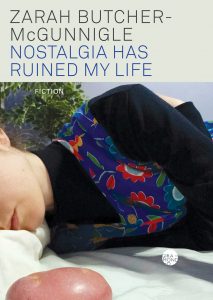 Nostalgia Has Ruined My Life
Nostalgia Has Ruined My Life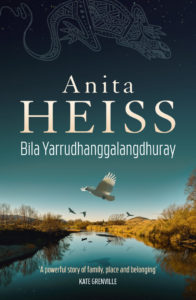 Bila Yarrudhanggalangdhuray
Bila Yarrudhanggalangdhuray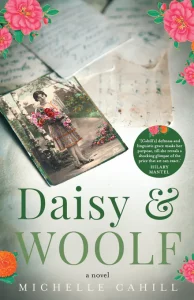 Daisy and Woolf
Daisy and Woolf SOPHIE CUNNINGHAM’S latest novel, This Devastating Fever, is forthcoming in September 2022 with Ultimo Press. She is the author of seven books, across multiple fiction and nonfiction, children and adults and include City of Trees – Essays on life, death and the need for a forest, and Melbourne. She is also editor of the collection Fire, Flood, Plague: Australian writers respond to 2020. Sophie’s former roles include as a book publisher and editor, chair of the Literature Board of the Australia Council, editor of the literary journal Meanjin, and co-founder of The Stella Prize celebrating women’s writing. She is now an adjunct professor at RMIT University’s non/fiction Lab. In 2019, Sophie was made a Member of the Order of Australia for her contributions to literature.
SOPHIE CUNNINGHAM’S latest novel, This Devastating Fever, is forthcoming in September 2022 with Ultimo Press. She is the author of seven books, across multiple fiction and nonfiction, children and adults and include City of Trees – Essays on life, death and the need for a forest, and Melbourne. She is also editor of the collection Fire, Flood, Plague: Australian writers respond to 2020. Sophie’s former roles include as a book publisher and editor, chair of the Literature Board of the Australia Council, editor of the literary journal Meanjin, and co-founder of The Stella Prize celebrating women’s writing. She is now an adjunct professor at RMIT University’s non/fiction Lab. In 2019, Sophie was made a Member of the Order of Australia for her contributions to literature. Where We Swim
Where We Swim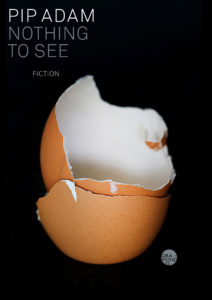 Nothing to See
Nothing to See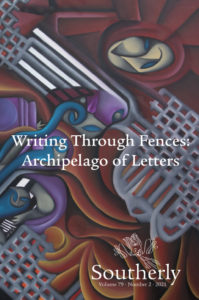 Writing Through Fences: Archipelago of Letters
Writing Through Fences: Archipelago of Letters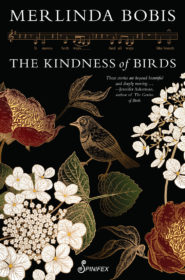 The Pigeons Are Taking Over: The Kindness of Birds
The Pigeons Are Taking Over: The Kindness of Birds 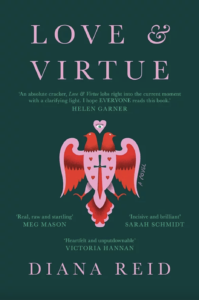 Love & Virtue
Love & Virtue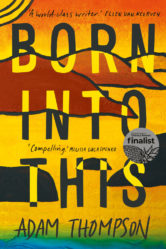 Born Into This
Born Into This